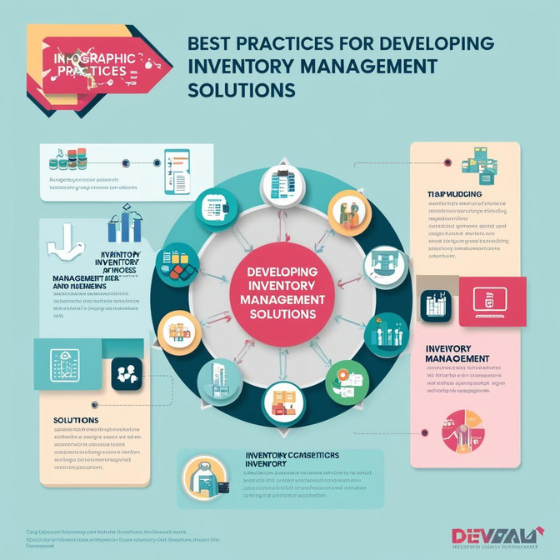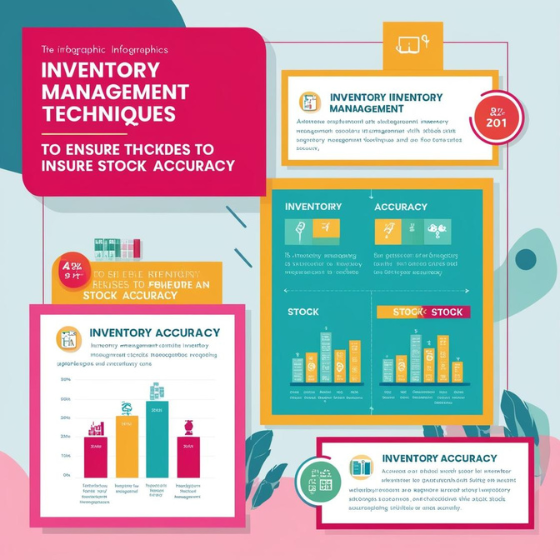Introduction
Effective inventory management is the backbone of any business that deals with physical products. Poor inventory management can lead to stockouts, overstocking, and operational inefficiencies, which negatively impact both customer satisfaction and the bottom line. But how can businesses develop inventory management solutions that are not only efficient but also scalable and future-proof?
In this blog, we will explore the best practices for developing inventory management solutions that optimize operations, reduce costs, and enhance customer service. Whether you are a small business or a large enterprise, implementing the right practices will ensure smoother operations, higher profitability, and a more reliable customer experience.
1. Implement Real-Time Inventory Tracking
Real-time inventory tracking is one of the most powerful features you can incorporate into your inventory management solution. It ensures that stock levels are accurately reflected at all times, preventing issues such as stockouts or overstocking.
Best Practices:
- Use Barcode or RFID Technology: Implementing barcode scanners or RFID tags allows you to track products in real time, minimizing the risk of errors and improving stock accuracy. When inventory is scanned, it automatically updates the system.
- Integrated Software Solutions: Choose an inventory management software that integrates with your point of sale (POS), warehouse management systems, and e-commerce platforms. This ensures that stock levels are updated instantly across all channels.
By implementing real-time tracking, you can make informed decisions quickly, respond to stock discrepancies, and optimize supply chain management.
2. Automate Replenishment and Ordering
Manual inventory management can be tedious and prone to human error, especially when it comes to replenishing stock. Automating the replenishment process ensures that your stock is always at optimal levels without the need for constant monitoring.
Best Practices:
- Set Reorder Points: Establish minimum stock levels for each product based on historical sales data and demand forecasts. Once inventory reaches a predetermined threshold, the system should automatically generate an order to restock the item.
- Use Predictive Analytics: Leverage predictive analytics and machine learning algorithms to forecast future demand based on historical data, trends, and seasonality. This allows you to better prepare for fluctuations in demand and reduce the likelihood of stockouts or excess inventory.
Automating replenishment not only saves time but also improves your ability to maintain stock accuracy and avoid running out of essential products.
3. Optimize Warehouse Organization
A well-organized warehouse is essential for effective inventory management. Disorganized stock can lead to misplaced products, delays in order fulfillment, and inefficiencies that hurt your bottom line.
Best Practices:
- Categorize and Label Inventory: Organize products into clearly labeled sections based on categories such as product type, demand frequency, or size. This makes it easier for your staff to locate items quickly, reducing time spent searching for products.
- Adopt a Warehouse Management System (WMS): A Warehouse Management System (WMS) helps you automate and optimize various warehouse processes, from receiving and storing inventory to picking, packing, and shipping orders. A WMS can improve stock accuracy, reduce errors, and speed up order fulfillment.
Efficient warehouse organization leads to better stock visibility, faster fulfillment, and overall improved customer satisfaction.
4. Conduct Regular Audits and Cycle Counts
Regular audits are critical to maintaining inventory accuracy. While full physical counts can be time-consuming, implementing regular cycle counts ensures that discrepancies between actual and recorded stock are identified and addressed in a timely manner.
Best Practices:
- Cycle Counting: Instead of doing a full inventory count once a year, consider conducting cycle counts regularly. This method involves counting a small subset of inventory daily, weekly, or monthly to ensure accuracy without shutting down operations.
- Spot Checks: Conduct random spot checks to verify stock levels in high-traffic areas of the warehouse or frequently ordered products. Spot checks help identify discrepancies early on and ensure inventory accuracy at all times.
Regular audits and cycle counts help businesses identify issues before they escalate, ensuring that stock discrepancies are resolved quickly and preventing issues in order fulfillment.
5. Implement a Centralized Inventory Management System
A centralized inventory management system ensures that all stock-related data is stored in one location and can be accessed by everyone involved in inventory management. This eliminates the confusion that can arise from managing inventory on separate platforms or spreadsheets.
Best Practices:
- Cloud-Based Solutions: Opt for a cloud-based inventory management system for real-time updates, accessibility, and better scalability. Cloud systems allow your team to access inventory data from anywhere, whether in the office or on the go.
- Integrated System: Ensure that your inventory system integrates seamlessly with other business operations such as sales, procurement, and finance. This creates a unified view of your inventory and makes it easier to manage data, track trends, and optimize workflows.
By centralizing your inventory management, you reduce the risk of errors and delays caused by miscommunication or outdated data.
6. Enable Efficient Reporting and Analytics
Effective inventory management goes beyond tracking stock levels—it also involves making data-driven decisions to optimize your operations. Implementing robust reporting and analytics within your inventory management system helps you gain insights into product performance, sales trends, and areas that require improvement.
Best Practices:
- Track Key Performance Indicators (KPIs): Identify and track KPIs such as inventory turnover rate, stockouts, backorders, and holding costs. These metrics provide insight into how well your inventory is performing and where improvements can be made.
- Generate Real-Time Reports: Use your inventory management software to generate real-time reports on stock levels, sales trends, and order fulfillment. Real-time reporting helps you make informed decisions quickly and adjust your strategy when necessary.
With proper analytics, you can optimize stock levels, reduce excess inventory, and make more informed purchasing decisions.
7. Ensure Strong Vendor Relationships
Your relationship with vendors directly impacts the efficiency of your inventory management system. Establishing strong partnerships with suppliers ensures that you receive quality products on time, which helps maintain accurate inventory levels and avoids disruptions in the supply chain.
Best Practices:
- Maintain Open Communication: Keep an open line of communication with your suppliers. Regularly review your inventory levels with them to ensure that they can meet your needs and adjust lead times if necessary.
- Negotiate Better Terms: Negotiate favorable terms such as bulk discounts, faster shipping, or shorter lead times. The better your supplier relationship, the more accurately you can manage your inventory and ensure stock availability.
Strong vendor relationships improve stock accuracy by ensuring timely deliveries and better overall inventory flow.
8. Integrate Multi-Channel Inventory Management
In today’s omnichannel retail environment, businesses often sell products through multiple platforms, including physical stores, e-commerce sites, and marketplaces like Amazon or eBay. Managing inventory across these channels can be challenging without the right tools.
Best Practices:
- Unified Inventory System: Use an integrated inventory management system that syncs across all sales channels. This ensures that stock levels are automatically updated across platforms and eliminates the risk of overselling or stockouts.
- Track Cross-Channel Demand: By integrating your inventory management solution with sales data from all channels, you can gain a better understanding of demand patterns and make smarter decisions about restocking and fulfillment.
Multi-channel inventory management ensures a seamless customer experience and accurate stock levels across all touchpoints.
Conclusion
Developing an efficient inventory management solution requires careful planning and the adoption of best practices that suit your business needs. Whether you’re automating replenishment, optimizing warehouse operations, or leveraging real-time tracking, these practices will help you maintain stock accuracy, streamline your processes, and improve overall operational efficiency.
At Sodio, we specialize in creating customized inventory management solutions that align with your business goals. If you’re ready to develop a more efficient inventory system, contact us today to learn how we can help streamline your operations and improve stock accuracy.
Looking for a customized inventory management solution? Get in touch with Sodio today to explore our services and take control of your inventory like never before!







